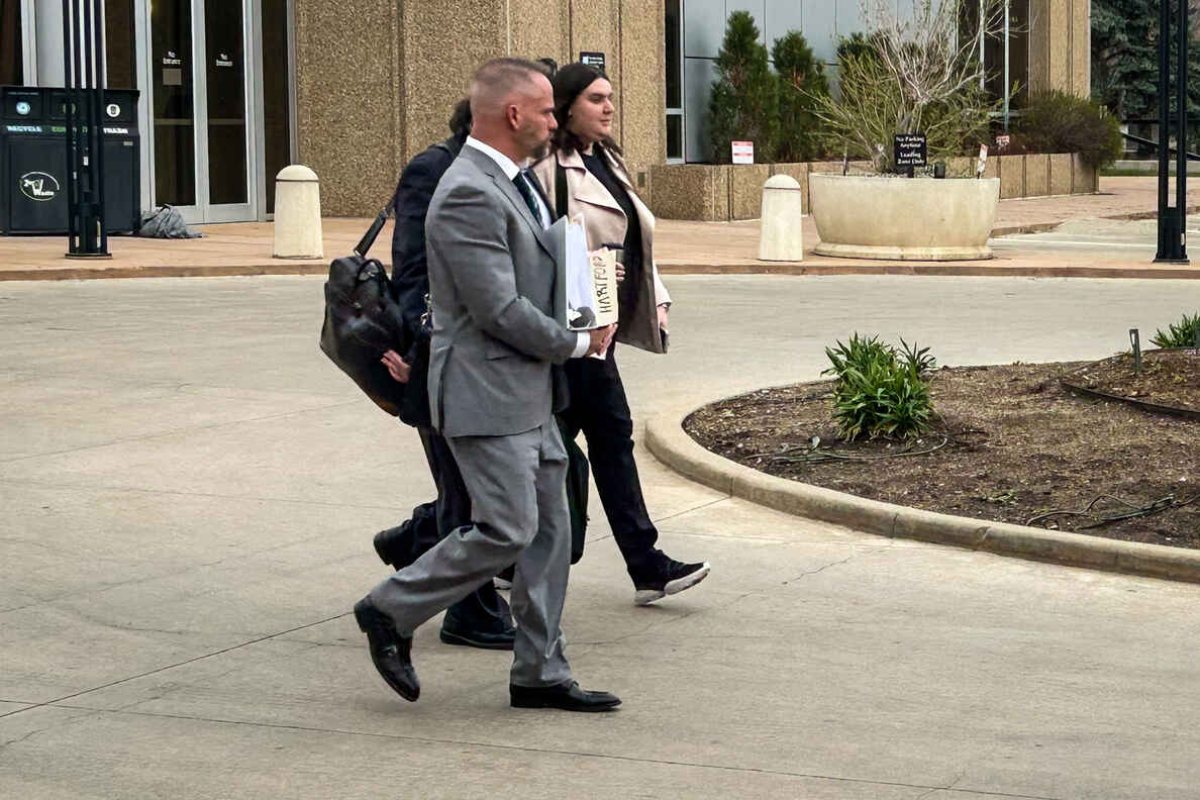

This story first aired April 5, 2016.
Lakewood writer Tom Lamarr and his wife became parents later in life. His new book "Geezer Dad" is about the path that eventually led them from years of fertility treatments to adoption.
The memoir contains a fair amount of sex, but it is far from sexy:
"We scheduled our intercourse -- the word love-making no longer applied -- so that it coincided with her peak ovulation. The result was Mussolini sex, getting those trains into the station on time with no thought for joy, desire, or human frailty."
Read an excerpt:
Chapter 5.The Things We Do for Love.Yes, I have debased myself in doctor’s offices. But discarding a few moments here and there, it wasn’t much fun and was never destined to become a fetish. I’m saying this upfront because it’s the most embarrassing thing in this chapter and possibly the book. Now, we can all take a deep breath and proceed (though I sincerely request you forget this chapter the moment you finish reading). For those lacking firsthand knowledge of artificial insemination, it’s survival of the fittest in microcosm. It’s also where the middleman comes into the process. Prospective dads agreeing to this option entrust their semen to licensed healthcare professionals who place it in a variety of Tupperware while washing it off, then toss it in the medical equivalent of a blender until the hardiest little swimmers rise to the top. “Keep paddling, Robert. For God’s sake, keep paddling.” This proud new race of supersperm is then inserted (in lay terms, squirted) deep into the appropriate vagina. The insertion-specialist-nurse employs a long, thin plastic tube to achieve this final goal. She’s aided, too, by metal torture devices that women apparently know from their visits to gynecologists, and that, for reasons unclear to me, have been stored on ice the night before. The nurse feigns ignorance—“I’m sorry. Is that cold?”—but I think she’s enjoying this. “Oh dear, it is uncomfortable, isn’t it?” Forget champagne. Forget flowers. This is romance, the kind one finds only in a doctor’s office with harsh fluorescent lighting—or sleeping on an in-law’s foldout couch. The first part of this process is tricky, of course, because as any man reading this knows, coming up with the goods is somewhat more complicated than saying, “Sperm? Sure, just happen to have some. And there’s plenty more where that came from.” Frankly, I haven’t been able to say this since I was seventeen and lying awake at night hosting impure thoughts about the airbrushed “supermodel” on the poster on my wall. These days, instant gratification takes forever, though my wife assures me this is a good thing. Not so at the fertility clinic, where no one has ever whispered, “Slow down, babe. Make it last.” The digital clock-radio might have been placed in the Donor Room to give nervous patients the option of soothing their savage beasts with music—“You’re grooving with Kenny G on E.Z. 105”—but I suspected its main purpose is to remind 7:30 Donor that 7:45 Donor was also paying good money for the privilege of using that room. As I quickly learned, artificial insemination requires a fair amount of manual participation—not to mention a level of concentration I always managed to leave at home—and I felt under the gun to produce. I didn’t need to hear someone pounding on the door. “Hey, pal, there’s a line out here. Give the rest of us a chance.” The funniest thing about artificial insemination is that sex is prohibited for three days beforehand. It’s important to build that sperm count, and God forbid I impregnate my wife without others looking on. Not so amusing are the cost and humiliation—two factors that helped make our first visit that much more memorable. The morning started with a twenty-minute drive to a doctors’ complex, taking separate cars so that Sam could continue on to work, where she would squirm in the same chair for eight hours straight, ignoring complaints from her stomach and bladder, while pressing her thighs together to ensure that nothing snuck back out. “Hold on, Robert! You’ve traveled too far to give in now. Swim toward the light. Swim toward the light.” Here’s how I recall that inaugural visit, conceding that my memory is helped by the fact we returned many times. The receptionist seems pleasant enough for 7:30 in the morning. “Cash upfront,” she says calmly, “credit cards welcome.” It hits me that this the closest I’ve ever come to paying for sex, though I’m willing to bet I’d get a lot more service in a Nevada brothel for the amount she’s putting on that card. She wants to see my insurance card too, and while I oblige, I already know our HMO won’t chip in because CIGNA treats this as if it were prostitution. I find this ironic, since they’re the ones who always leave us feeling screwed. Once my cards are back in my wallet and I’ve signed away the equivalent of a Cambodian teacher’s annual wages, a nurse appears in a doorway. She invites me to “Come this way, Tom,” and leads me to a dimly lit room, small for an office, spacious for a Men’s room. Furnished with couch, cabinet, and yes, sink and toilet, this is the Donor Room. She stops shy of the door ... so much for her willingness to help, as well as the shameful state of healthcare in the United States. The door closes and I must try to remember why we’re doing this, I must think of “the baby.” But the idea of new life seems as alien to this place as pro bono clients. The walls are spare, no Sears Family Portraits of wide-eyed, smiling toddlers, no wallpaper-trim depictions of hippos and hamsters and sidewinder snakes queuing to board an ark. Blinds hide a window on the opposite wall. These probably open to the street; I figure I’ll keep them closed. Next, I’m looking under the couch and prying open cabinet doors until I find a stack of Playboys and something called Perfect 10, cringing at the thought that these magazines have been touched by hundreds of other men wearing their underwear down around their ankles. At least there’s soap and water in a dispenser above the sink, and as I proceed to Step Two—underwear in place—I am further aroused by the sounds of professional healthcare technicians going about their business. “Oh, please, nursey, please,” I want to shout. “You dirty, dirty girl. Could you repeat those words, Do we have a sperm count for Mr. Smith?” I must concentrate … concentrate … and stop glancing at the stupid digital clock. Go away, Mr. Smith. Get out of my fantasy. Just try to focus on the task at hand. Ah, that’s better … better … better. Oh god, Miss November, will you mother my child? Finally, the cap goes on the plastic vial, at which time I’m grateful to have already jotted my last name on an adhesive label that will grace the container. With pride and shaky penmanship, I do add one last piece of information, writing 100 on the “Percent of emission” line. More good news: No one’s pounding on the door. But this doesn’t mean I’m in the clear. I must deposit my deposit in an in-box conveniently located on the middle of a wide, bright counter near the front desk (I’m waiting for a bell or siren to sound) and crawl back into the waiting room, avoiding the eyes of lesbian couples who are clearly thinking, Jeez, I hope they don’t give us his sperm. Once in the seat Sam’s been saving for me, I try to read the morning paper, hoping I won’t find headlines on the order of, “Childless Colorado Author Masturbates in Doctor’s Office.” Concentrate … concentrate. This is when my wife takes my hand—the other one—and calms me by saying, “Honey, where did you leave your pants?” I won’t see my sperm for another hour, and some of it, sadly, is lost to me forever. But for my adventurous seed, it’s an eventful sixty minutes, basically the sperm equivalent of those “reality” game shows created by visionaries at Fox and CBS to avoid paying writers and actors (and to convince terrorist organizations that our culture really isn’t worth attacking). “Tonight on Survival Down Under, find out which unlucky spermatozoon gets voted off the tube? The viewer decides the outcome, something you can’t say for The Sopranos or West Wing—or for that matter, books. Eight o’clock. Seven central.” Sam and I spend most of the hour in relative calm, fidgeting, reading, and trying not to peek at the other infertile couples that enter and exit the clinic. After forty minutes, we’re escorted to a room that looks like a real doctor’s office. It smells like one too, alcohol-clean, gamete-free. The nurse stays with us, no freezing up at the door this time. I ask about the expensive-looking machine that takes up a third of the room. “It’s an ultrasound device,” she explains, leaving off the words, “that you two will be paying for.” She lifts a phallic cylinder that’s attached to the machine by way of vacuum cleaner hose. But the image the nurse wishes to maintain is the phallic one, so she places something that looks a lot like a prophylactic over the cylinder’s head (Where was this mental image when I was stuck in that other room?) and lubricates it with a Vaseline-like gel. Gleaming in the room’s bright lighting—here the overhead lights burn like the sun, the sun as seen from Mercury—this attachment shows no desire to erase old stereotypes. It behaves as expected, promptly making its way to my wife’s most private parts. But here’s a surprise. This phallus does one thing mine cannot—it takes pictures—and soon, we’re looking at scenes from inside the womb on a twenty-inch screen similar to a computer’s monitor. These images require some imagination on my part; they’re murky and gray and could well be shots of caverns from a PBS nature special. “We are careful not to disturb the nesting vampire bats. Oh darn. We have disturbed the nesting vampire bats.” The nurse tells us that she’s spotted an egg. “Looking good. Ooh, there’s a second one in the left ovary. Excellent. Excellent.” For my wife, hearing these kind words may be the only pleasure she gets in return for her trio of sex-free days. But I don’t think it does much for her. She’s never been vain about her eggs. Besides, she’s about to learn that our nurse is free and easy with compliments. When the sperm make their entrance, already assembled in their slim plastic tube, the nurse beams. “This is excellent, Mr. LaMarr. The motility is excellent. We’re looking good.” The count is something like 87 trillion, give or take a few zeroes, meaning that my wife would have to produce several more eggs to make this a fair contest. “It’s looking great,” the nurse exclaims, her pitch rising. “An excellent sample.” It’s my turn now to feel uneasy. After decades of waiting for someone to tell me I’m good at something, I’m disappointed to learn it’s masturbation. “Not all sperm are created equal,” the nurse adds. “Our process weeds out the weaker specimens.” She seems proud of her role in this Darwinian death match. “Plus, semen only live three days. Our aim is to achieve a younger, more vital population.” I am pleased to discover that the final step is not so cold and mechanical. (Well, actually it is cold, thanks to that freeze-dried gadget.) Sam and I hold hands and I press the trigger that completes the ancient insemination ritual. “Slow down, Mr. LaMarr,” the nurse whispers. “Make it last.” Smiling, she turns out the lights and leaves the room. She must also have pressed a button on this room’s clock-radio, because an announcer is saying, “You’re listening to the Big E.Z. and we’re grooving with Kenny G.” “Thanks for doing this,” Sam says. “You know it’s important to me.” Heading home, I feel empty and weak, and I’m reminded of driving back to my apartment when I was in my twenties and dates sometimes stretched into wee morning hours. Since I’m reliving those memories, there’s only one thing for me to do: stop and get fast food. A biscuit sounds good. “It could’ve been worse,” a friend explained a few years later. “It could’ve been much, much worse.” Pete had just become an adoptive dad, and I had just learned that he too was a fertility clinic veteran. During his first visit, he disclosed, he pried open the cabinet doors only to find a selection of medical publications. No doubt humming “The Things We Do for Love” to himself, Pete chose to soldier on. For him, unfortunately, this did turn into a fetish, and to this day his wife is perplexed by his subscription to the Journal of the American Medical Association. Pete works in advertising. Non-medical clients. “Pete, honey, it’s bedtime. You’re straining your eyes with all that reading. It’s been half an hour. There’s a line out here. Give the rest of us a chance.” Reprinted from GEEZER DAD: HOW I SURVIVED INFERTILITY CLINICS, FATHERHOOD JITTERS, ADOPTION WAIT LIMBO & THINGS THAT GO “WAA” IN THE NIGHT by Tom LaMarr with permission from Marcinson Press. Copyright (c) Tom LaMarr 2015. |








